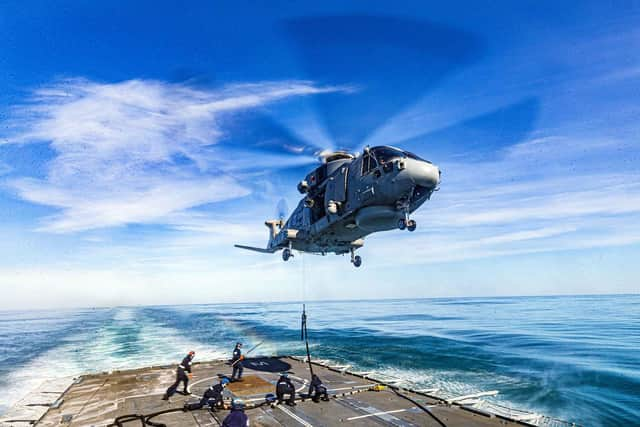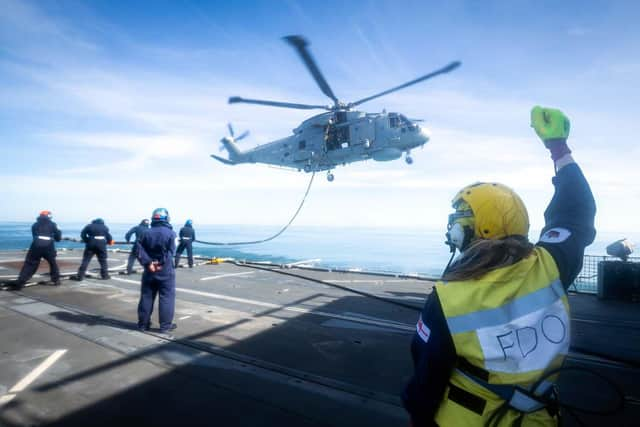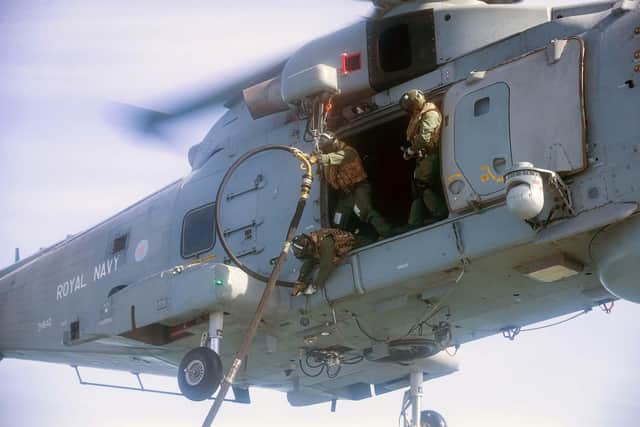Submarine-hunting Merlin helicopter completes challenging mid-air refuelling above Portsmouth Royal Navy warship
and live on Freeview channel 276
The tricky manoeuver was performed by aviators from 814 Naval Air Squadron in a Merlin during a Nato exercise in Iceland.
The 14.5-tonne chopper was fuelled up by a team from Portsmouth-based frigate HMS Westminster, under the direction of Flight Deck Officer Petty Officer Amanda Drake.
Advertisement
Hide AdAdvertisement
Hide AdMerlin anti-submarine patrols can last several hours – and for a sustained hunt several helicopters operate in rotation around the clock to never give the underwater threat a breather.


Topping up fuel without landing on the deck and shutting down is quicker and helps keep the pressure up on the underwater threat lurking below.
But the challenging task is not without its drawbacks.
A Royal Navy spokesman said: ‘The helicopter uses around 800kg of fuel every hour it’s airborne – but that can rise to one tonne of fuel for 60 minutes in the hover, when the helicopter has its dipping sonar lowered in the ocean as it closes in on its submarine foe.


‘That’s because in the hover it’s purely engine power keeping the weight of the aircraft in the air; forward flight creates aerodynamic lift which lowers the rate of fuel consumption.’
Advertisement
Hide AdAdvertisement
Hide AdRefuelling isn’t quick, either, with about one to 1.2 tonnes of fuel entering the Merlin’s tanks every hour.
The effort also leaves crews exposed to the elements and constantly battling the mighty downwash from the helicopter, with wind speeds hitting in excess of 200mph.


On this occasion, the refuelling effort went off without a hitch.
It was part of a major Nato exercise called Dynamic Mongoose, which was staged off the coast of Iceland earlier this month.
Advertisement
Hide AdAdvertisement
Hide AdWarships, submarines and air power from six alliance nations took part in the war games in an effort to sharpen Nato’s sub-hunting teeth.
The drill came amid a rise in Russian submarine activity in the region.
A message from the Editor
Thank you for reading this story. The dramatic events of 2020 are having a major impact on our advertisers and thus our revenues.
The News is more reliant than ever on you taking out a digital subscription to support our journalism. You can subscribe here for unlimited access to Portsmouth news and information online.
Every subscription helps us continue providing trusted, local journalism and campaign on your behalf for our city.
Comment Guidelines
National World encourages reader discussion on our stories. User feedback, insights and back-and-forth exchanges add a rich layer of context to reporting. Please review our Community Guidelines before commenting.